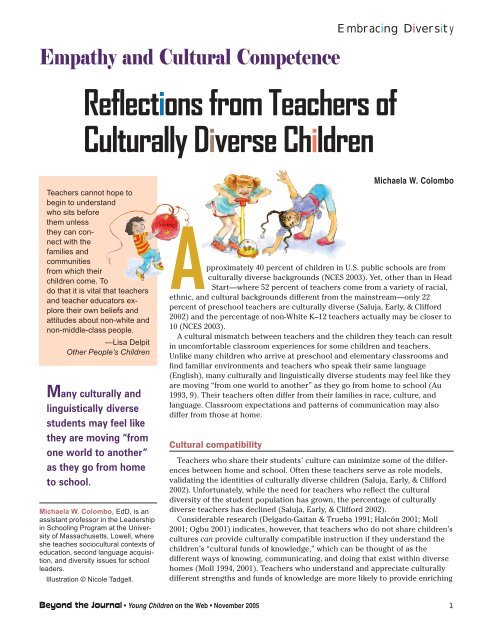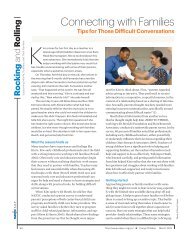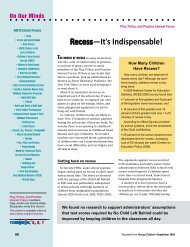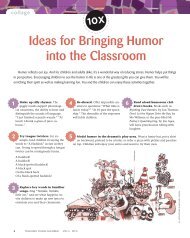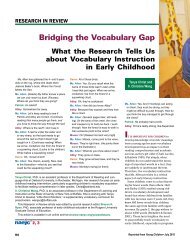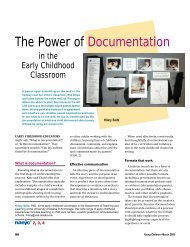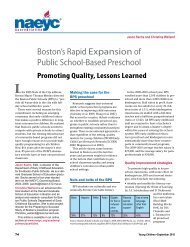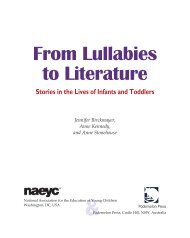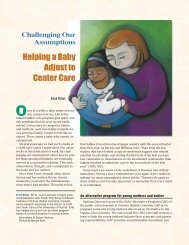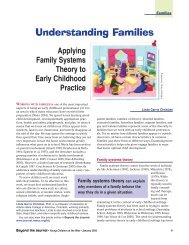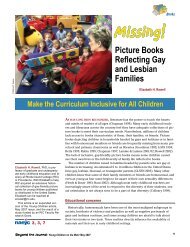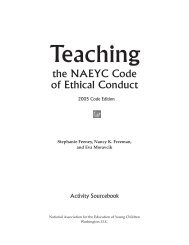Reflections from Teachers of Culturally Diverse Children - National ...
Reflections from Teachers of Culturally Diverse Children - National ...
Reflections from Teachers of Culturally Diverse Children - National ...
You also want an ePaper? Increase the reach of your titles
YUMPU automatically turns print PDFs into web optimized ePapers that Google loves.
Empathy and Cultural Competence<br />
Embracing Diversity<br />
<strong>Reflections</strong> <strong>from</strong> <strong>Teachers</strong> <strong>of</strong><br />
<strong>Culturally</strong> <strong>Diverse</strong> <strong>Children</strong><br />
<strong>Teachers</strong> cannot hope to<br />
begin to understand<br />
who sits before<br />
them unless<br />
they can connect<br />
with the<br />
families and<br />
communities<br />
<strong>from</strong> which their<br />
children come. To<br />
do that it is vital that teachers<br />
and teacher educators explore<br />
their own beliefs and<br />
attitudes about non-white and<br />
non-middle-class people.<br />
—Lisa Delpit<br />
Other People’s <strong>Children</strong><br />
Many culturally and<br />
linguistically diverse<br />
students may feel like<br />
they are moving “<strong>from</strong><br />
one world to another”<br />
as they go <strong>from</strong> home<br />
to school.<br />
Michaela W. Colombo, EdD, is an<br />
assistant pr<strong>of</strong>essor in the Leadership<br />
in Schooling Program at the University<br />
<strong>of</strong> Massachusetts, Lowell, where<br />
she teaches sociocultural contexts <strong>of</strong><br />
education, second language acquisition,<br />
and diversity issues for school<br />
leaders.<br />
Illustration © Nicole Tadgell.<br />
Approximately 40 percent <strong>of</strong> children in U.S. public schools are <strong>from</strong><br />
culturally diverse backgrounds (NCES 2003). Yet, other than in Head<br />
Start—where 52 percent <strong>of</strong> teachers come <strong>from</strong> a variety <strong>of</strong> racial,<br />
ethnic, and cultural backgrounds different <strong>from</strong> the mainstream—only 22<br />
percent <strong>of</strong> preschool teachers are culturally diverse (Saluja, Early, & Clifford<br />
2002) and the percentage <strong>of</strong> non-White K–12 teachers actually may be closer to<br />
10 (NCES 2003).<br />
A cultural mismatch between teachers and the children they teach can result<br />
in uncomfortable classroom experiences for some children and teachers.<br />
Unlike many children who arrive at preschool and elementary classrooms and<br />
find familiar environments and teachers who speak their same language<br />
(English), many culturally and linguistically diverse students may feel like they<br />
are moving “<strong>from</strong> one world to another” as they go <strong>from</strong> home to school (Au<br />
1993, 9). Their teachers <strong>of</strong>ten differ <strong>from</strong> their families in race, culture, and<br />
language. Classroom expectations and patterns <strong>of</strong> communication may also<br />
differ <strong>from</strong> those at home.<br />
Cultural compatibility<br />
Michaela W. Colombo<br />
<strong>Teachers</strong> who share their students’ culture can minimize some <strong>of</strong> the differences<br />
between home and school. Often these teachers serve as role models,<br />
validating the identities <strong>of</strong> culturally diverse children (Saluja, Early, & Clifford<br />
2002). Unfortunately, while the need for teachers who reflect the cultural<br />
diversity <strong>of</strong> the student population has grown, the percentage <strong>of</strong> culturally<br />
diverse teachers has declined (Saluja, Early, & Clifford 2002).<br />
Considerable research (Delgado-Gaitan & Trueba 1991; Halcón 2001; Moll<br />
2001; Ogbu 2001) indicates, however, that teachers who do not share children’s<br />
cultures can provide culturally compatible instruction if they understand the<br />
children’s “cultural funds <strong>of</strong> knowledge,” which can be thought <strong>of</strong> as the<br />
different ways <strong>of</strong> knowing, communicating, and doing that exist within diverse<br />
homes (Moll 1994, 2001). <strong>Teachers</strong> who understand and appreciate culturally<br />
different strengths and funds <strong>of</strong> knowledge are more likely to provide enriching<br />
Beyond the Journal • Young <strong>Children</strong> on the Web November 2005 1
© Subjects & Predicates<br />
Beginning the journey<br />
toward increased cultural<br />
competence requires<br />
teachers to rethink their<br />
assumptions and consider<br />
life’s issues through<br />
the lenses <strong>of</strong> people who<br />
come <strong>from</strong> cultural backgrounds<br />
different <strong>from</strong><br />
their own.<br />
Embracing Diversity<br />
and responsive learning environments that celebrate and capitalize on<br />
children’s cultural differences.<br />
Still, understanding and acknowledging the validity <strong>of</strong> different cultural<br />
behaviors and beliefs can present challenges for some teachers. As students<br />
themselves, most teachers were socialized in mainstream schools for at least<br />
12 years (Cuban 1993) and <strong>of</strong>ten attended teacher preparation programs<br />
grounded in the mainstream culture. In centers and schools, many teachers<br />
then find themselves working with colleagues who have similar educational<br />
and pr<strong>of</strong>essional experiences.<br />
Beginning the journey toward increased cultural competence (the ability to<br />
understand diverse perspectives and appropriately interact with members <strong>of</strong><br />
other cultures in a variety <strong>of</strong> situations) requires teachers to rethink their<br />
assumptions and consider life’s issues through the lenses <strong>of</strong> people who come<br />
<strong>from</strong> cultural backgrounds different <strong>from</strong> their own.<br />
The activities most likely to increase cultural competence are those that<br />
immerse teachers in meaningful interactions with members <strong>of</strong> other cultures<br />
and promote cultural disequilibrium or a sense <strong>of</strong> being lost (Sleeter 1995).<br />
This article describes one such pr<strong>of</strong>essional development initiative that<br />
combined course work with cultural immersion experiences designed to create<br />
this sense <strong>of</strong> disequilibrium.<br />
A pr<strong>of</strong>essional development initiative to<br />
increase teacher empathy<br />
The public schools in one suburban Massachusetts city<br />
sponsored a pr<strong>of</strong>essional development initiative designed<br />
to educate teachers about their Latino students’ unique<br />
cultural backgrounds. Latino families form the largest nonmainstream<br />
cultural and linguistic group in the school<br />
district. Twenty-seven White teachers <strong>of</strong> pre-K through<br />
third grade participated in course work, cultural immersion<br />
experiences, and interactions with culturally diverse<br />
families.<br />
<strong>Teachers</strong> attended 12 workshops and participated in<br />
two Family Literacy Nights with Latino families and their<br />
children. The Family Literacy Nights were tailored to the<br />
needs and characteristics <strong>of</strong> several Latino cultures.<br />
Spanish is the home language for all <strong>of</strong> the families, many<br />
<strong>of</strong> whom have limited pr<strong>of</strong>iciency in English. Many parents<br />
work long hours for minimal wages, and most <strong>of</strong> the<br />
children participate in the school’s free and reduced-price<br />
breakfast and lunch programs.<br />
In activities that simulated the experience <strong>of</strong> being part<br />
<strong>of</strong> a cultural and linguistic minority group, teachers played<br />
games in which the rules continually changed and the<br />
language was unfamiliar. Group debriefing exercises<br />
followed. The teachers were encouraged to think about<br />
their own cultural perspectives and recognize multiple<br />
perspectives as well as cultural and linguistic differences.<br />
At Family Literacy Nights, teachers participated in<br />
storybook reading and activities in both English and<br />
Spanish, learned about parents’ interests through ongoing conversations with<br />
them, helped children with homework, and supported parents during English<br />
Beyond the Journal Young <strong>Children</strong> on the Web November 2005 2
© Subjects & Predicates<br />
Ignoring cultural differences<br />
can perpetuate a<br />
deficit model that seeks<br />
to “fix” culturally diverse<br />
children, making them<br />
more like their mainstream<br />
peers rather than<br />
celebrating their unique<br />
cultural backgrounds.<br />
Embracing Diversity<br />
as a second language (ESL) activities. A<br />
variety <strong>of</strong> guest speakers spoke about<br />
the school’s structure, expectations,<br />
and available services.<br />
Although the target for Family<br />
Literacy Nights was children <strong>from</strong> age<br />
four to seven, to support attendance<br />
the program coordinators encouraged<br />
families to bring all their children,<br />
babies to teenagers. Grandparents and<br />
other family members were also<br />
welcome.<br />
Challenging misconceptions<br />
As part <strong>of</strong> a research initiative with a<br />
local university, teacher participants<br />
were interviewed during and following<br />
the pr<strong>of</strong>essional development series.<br />
This article focuses on teachers’ views<br />
with regard to four commonly held<br />
misconceptions that had been expressed<br />
by some teachers before the<br />
workshop series. We hope that their<br />
reactions and thoughts and some <strong>of</strong> our subsequent suggestions help other<br />
teachers increase their cultural competence.<br />
Misconception 1—Everyone is the same<br />
(children are children, families are families)<br />
Prior to the pr<strong>of</strong>essional development series, a kindergarten teacher declared<br />
<strong>of</strong> her diverse classroom, “<strong>Children</strong> are children.” Yet, by not acknowledging<br />
differences, this teacher may have denied the children’s cultural strengths.<br />
<strong>Children</strong> <strong>from</strong> other cultures <strong>of</strong>ten have patterns <strong>of</strong> communication, interaction,<br />
and participation that may be different <strong>from</strong> those valued within mainstream<br />
schools. If the teacher doesn’t see the richness in children’s communication<br />
and interaction, she may inadvertently project her mainstream cultural<br />
values for understanding, speaking, and interacting with children. Ignoring<br />
children’s cultural differences and strengths can perpetuate a deficit model<br />
that seeks to “fix” culturally diverse children, making them more like their<br />
mainstream peers rather than celebrating their unique cultural backgrounds.<br />
Following the pr<strong>of</strong>essional development workshops, a second-grade teacher<br />
expressed a viewpoint that was echoed by other participants: “We think everyone<br />
is like us until we spend some time with them and realize their strengths<br />
and struggles.” Some teachers wanted to learn more about Latino culture. One<br />
teacher said, “As mothers, we cross all bounds <strong>of</strong> cultural diversity because we<br />
all want what’s best for our children, yet our Latino parents bring rich cultural<br />
differences. I’d like to know more about their language and cultures.”<br />
Seeing the children and their families communicate with each other in their<br />
home language was an important learning experience for several <strong>of</strong> the teachers.<br />
The young Spanish-speaking children were learning English, and yet the<br />
teachers witnessed a rich expressiveness as the children and their families<br />
communicated in their home language. A kindergarten teacher noted, “Listening<br />
to the children interact with each other and their families has changed the<br />
Beyond the Journal Young <strong>Children</strong> on the Web November 2005 3
Embracing Diversity<br />
way I see them. Yes, they speak English, but when they speak Spanish, they<br />
speak in beautiful, rich sentences.”<br />
By immersing teachers in language they didn’t understand, the experience<br />
created a strong sense <strong>of</strong> empathy among teachers for both parents and<br />
children. One teacher, glimpsing the difficulties <strong>of</strong> learning another language,<br />
said, “I was trying to explain the ESL lesson [to a parent] and realized that no<br />
matter how much I dug into my bag <strong>of</strong> tricks, she did not understand me. It<br />
gave me an appreciation for the patience, determination, and frustration<br />
parents must feel every day, having to work, shop, or go anyplace knowing that<br />
they might not get what they want because they’re not understood.”<br />
Misconception 2—<strong>Culturally</strong> diverse parents should know<br />
and conform to the expectations <strong>of</strong> mainstream schools<br />
Prior to the pr<strong>of</strong>essional development initiative, a group <strong>of</strong> teachers had<br />
discussed ways to increase the involvement <strong>of</strong> culturally and linguistically<br />
diverse families. An elementary grade teacher who was present stated, “I know<br />
we’re all different, but we’re in the United States. Our students and families live<br />
here. When in Rome, do as the Romans do.” Several other teachers nodded in<br />
agreement.<br />
Delpit (1995) would argue that doing “what the Romans do” means first<br />
knowing what it is that the Romans<br />
do. Most culturally and linguistically<br />
Developing Cultural Competence:<br />
Suggestions for <strong>Teachers</strong><br />
Illustrating the Complexity <strong>of</strong> Learning a<br />
Second Language<br />
Take a cultural/linguistic immersion trip by dining at authentic ethnic<br />
restaurants where English is not spoken and you’re not sure <strong>of</strong> the<br />
cultural norms. Remember, any sense <strong>of</strong> discomfort is temporary; you can<br />
return to your English-speaking environment. Although visiting a place<br />
where another language is spoken is by no means the equivalent <strong>of</strong> living<br />
in a culture in which one does not know the mainstream language, it can<br />
provide some initial insight into such a predicament.<br />
Value the burgeoning bilingualism <strong>of</strong> your second-language learners.<br />
Choose good multilingual children’s books (both fiction and nonfiction) for<br />
your classroom. Encourage parents to communicate with and read to their<br />
children in their first language as well as English.<br />
Imagine completing an educational degree in another language. Consider<br />
the linguistic sophistication it would require.<br />
Explore research on second-language acquisition (such as Baker 2001).<br />
The <strong>National</strong> Clearinghouse for English Language Acquisition (NCELA—<br />
www.ncela/gwu.edu) provides information and resources in English and<br />
Spanish for teachers, families, and community members; <strong>Teachers</strong> <strong>of</strong><br />
English to Speakers <strong>of</strong> Other Languages (TESOL—www.tesol.org)<br />
provides lists <strong>of</strong> resources for teachers; and the <strong>National</strong> Association for<br />
Bilingual Education (NABE—www.nabe.org) features research articles<br />
and many references.<br />
diverse families have had experiences<br />
that differ <strong>from</strong> those reflected<br />
in the expectations <strong>of</strong> mainstream<br />
schools. Even when parents do understand<br />
school expectations such<br />
as storybook reading and reinforcing<br />
classroom learning with their children,<br />
they may not have the necessary<br />
resources in terms <strong>of</strong> language<br />
and time to meet these expectations.<br />
Some linguistically diverse parents<br />
have completed high levels <strong>of</strong> education<br />
in their country <strong>of</strong> origin but<br />
have difficulty communicating in<br />
English; others have had limited<br />
formal schooling but have had a rich<br />
array <strong>of</strong> life experiences. Many work<br />
very long hours to provide their<br />
children with necessities.<br />
Following the pr<strong>of</strong>essional development<br />
sessions, one teacher spoke<br />
<strong>of</strong> the need for better communication<br />
so the families can understand<br />
teacher and school expectations.<br />
She explained, “We were surprised<br />
to learn that for some parents there<br />
is a huge separation between school<br />
and home. Some parents believe the<br />
teacher is responsible for the child’s<br />
learning and have no idea <strong>of</strong> the role<br />
we expect them to play in reinforc-<br />
Beyond the Journal Young <strong>Children</strong> on the Web November 2005 4
© Subjects & Predicates<br />
Embracing Diversity<br />
ing reading and classroom learning at home. Once you meet with parents and<br />
explain your expectations, they do try to help their children at home.” Other<br />
teachers mentioned the importance <strong>of</strong> discussing school routines and services<br />
with parents. Said one, “I can’t imagine being in another country where I wasn’t<br />
sure <strong>of</strong> the rules and expectations.”<br />
Several teachers marveled at the complexity <strong>of</strong> language learning. As one<br />
explained, “I really have learned that I need to take extra time to make sure that<br />
English language learners know exactly what to do, because their parents may<br />
want to help but do not have the necessary English vocabulary to read with<br />
their children and support classroom instruction.<br />
Misconception 3—Families who don’t participate in<br />
school activities don’t value education<br />
One impetus for the pr<strong>of</strong>essional development workshop series was teachers’<br />
perceived lack <strong>of</strong> understanding as to how transportation, work schedules, and<br />
locations affect parents’ ability to attend school meetings. The comment <strong>of</strong> one<br />
teacher illustrates this misconception: “You can tell the parents who care,” she<br />
said. “When I have a parent meeting, none <strong>of</strong><br />
my parents come. It is so hard to work with<br />
children without parental support.”<br />
When parents don’t regularly attend<br />
school functions, some teachers assume<br />
this reflects a lack <strong>of</strong> concern. Yet, as most<br />
teachers who participated in the Family<br />
Literacy Nights realized, there is no lack <strong>of</strong><br />
concern on the part <strong>of</strong> families. Many<br />
teachers indicated their surprise at the<br />
number <strong>of</strong> parents and children who<br />
attended the family literacy events twice<br />
weekly both in the evenings and also in<br />
morning sessions, which were added at the<br />
request <strong>of</strong> parents. Holding Family Literacy<br />
Nights in a central location, within walking<br />
distance for most families, and scheduling<br />
evening and morning meetings made the<br />
events accessible to parents who work<br />
different shifts and/or don’t own cars or<br />
have access to public transportation. “We<br />
need to make schools more accessible and<br />
welcoming. Then parents will come,”<br />
remarked a third-grade teacher. Research<br />
supports her conclusion; teachers who believe in their efficacy to involve<br />
families achieve high parental involvement regardless <strong>of</strong> parents’ background<br />
or socioeconomic status (Hoover-Dempsey, Bassler, & Bridsie 1987).<br />
A first grade teacher echoed most teachers’ reactions to parental participation<br />
and their new awareness <strong>of</strong> the extra effort required for parents to participate<br />
in the Family Literacy Nights: “It was wonderful to see mothers with their<br />
children, knowing that it wasn’t easy to get there, they don’t have the transportation,<br />
and they’re going to get home a little bit later that night. They put<br />
everything aside [to attend].”<br />
The teachers viewed the video My Brown Eyes (Koh 1994), which shows a<br />
day in the life <strong>of</strong> a young Korean immigrant child and his parents, who work<br />
long hours to provide for him. Afterward, the teachers acknowledged the<br />
Beyond the Journal Young <strong>Children</strong> on the Web November 2005 5
Developing Cultural Competence:<br />
Suggestions for <strong>Teachers</strong><br />
Fostering Empathy<br />
Get to know families in their homes, neighborhoods, or places <strong>of</strong><br />
worship. Talk with parents and discover the diverse strengths within<br />
families. Explore family customs and history and make these an integral<br />
part <strong>of</strong> your curriculum.<br />
Be aware <strong>of</strong> your own feelings and reactions when visiting culturally<br />
different communities. By placing yourself in situations that cause a<br />
sense <strong>of</strong> cultural disequilibrium, you can better understand how the<br />
children and their families feel when they come to school.<br />
Embracing Diversity<br />
practical challenges that many<br />
families confront each day. As one<br />
teacher said, “If parents have to work<br />
12- or 15-hour days to support their<br />
children, they may not be able to<br />
attend school functions or provide<br />
homework support, no matter how<br />
important they feel education is.”<br />
Misconception 4—If you want<br />
children to learn English, just<br />
speak English<br />
Prior to the workshop series,<br />
several Latino parents had expressed<br />
concern because their children’s<br />
teachers had advised them to speak<br />
and read in English and to avoid<br />
speaking Spanish at home because it<br />
confuses their children. “I can’t speak<br />
English,” one parent said through an<br />
interpreter. “What can I do?”<br />
Young children are able to learn<br />
more than one language well, and<br />
children who fully develop two<br />
languages enjoy cognitive advantages,<br />
especially in the areas <strong>of</strong><br />
divergent thinking and linguistic<br />
competence (Baker 2001). <strong>Children</strong><br />
who become balanced bilinguals<br />
(develop equal competence in both<br />
languages) can differentiate between languages and accurately switch languages<br />
when appropriate. In a study <strong>of</strong> Puerto Rican children in the United<br />
States, the children developed complex linguistic abilities at a young age,<br />
accurately switching between English and Spanish depending upon their<br />
perceptions <strong>of</strong> their audience (Zentella 1997).<br />
To illustrate the absurdity <strong>of</strong> requiring non-English speaking parents to use<br />
only English with their children, one workshop presenter displayed a drawing<br />
<strong>of</strong> a smiling dog wearing dentures and asked the teachers to work in small<br />
groups to develop rich descriptions <strong>of</strong> the illustration. Participants read their<br />
sentences aloud, displaying their native English linguistic abilities. Next the<br />
presenter asked teachers to again generate descriptive sentences, but this time<br />
in a second language. None <strong>of</strong> the teacher participants was able to do so. “And<br />
if you were able to,” the presenter asked, “would your writing have the same<br />
quality and richness as it did when you wrote in English?” Throughout the<br />
room, teachers shook their heads.<br />
The point was made. The teachers saw the importance <strong>of</strong> encouraging<br />
parents to use their most pr<strong>of</strong>icient and richest language when speaking with<br />
their children. “Now I really understand [the damage] we do when we ask<br />
parents to only speak English—now I know,” said one teacher. Encouraging<br />
parents to read to their children in their richest language builds English<br />
language reading because abilities developed in the first language transfer to<br />
English. Reading in the first language also keeps parents with limited English<br />
pr<strong>of</strong>iciency involved in their children’s literacy development. <strong>Children</strong> also<br />
Read adult literature about other cultures written by authors <strong>from</strong> those<br />
cultures. For example, for Latino cultures, consider the writings <strong>of</strong> Julia<br />
Alvarez, Esmeralda Santiago, Sandra Cisneros, or Gary Soto. Authentic<br />
multicultural literature is available at many public libraries, large book<br />
stores, and online retailers.<br />
View My Brown Eyes (Koh 1994) with a colleague. Keep notes <strong>of</strong> your<br />
reactions and share your ideas with each other.<br />
Read educational books that recognize and celebrate differences in<br />
young children, such as Other People’s <strong>Children</strong> (Delpit 1995), White<br />
Teacher (Paley 2005), The Girl with the Brown Crayon (Paley 1997),<br />
Kwanzaa and Me (Paley 1995), and The Light in Their Eyes: Creating<br />
Multicultural Learning Communities (Nieto 1999).<br />
Young children are able<br />
to learn more than one<br />
language well, and children<br />
who fully develop<br />
two languages enjoy<br />
cognitive advantages,<br />
especially in the areas <strong>of</strong><br />
divergent thinking and<br />
linguistic competence.<br />
Beyond the Journal Young <strong>Children</strong> on the Web November 2005 6
© Lois Main<br />
Most teachers gained a<br />
greater understanding <strong>of</strong><br />
the complexity <strong>of</strong><br />
language and second<br />
language literacy.<br />
Embracing Diversity<br />
benefit <strong>from</strong> reading to their parents in English. Parents who attended Family<br />
Literacy Nights <strong>of</strong>ten borrowed both tape recorders and English books on tape<br />
so they could read with their children.<br />
Most teachers gained a greater understanding <strong>of</strong> the complexity <strong>of</strong> language<br />
and second language literacy. As one kindergarten teacher summarized, “Being<br />
immersed in Spanish reading was good for me. This role playing was so important.<br />
We were reading a Big Book [in Spanish], and I was trying to figure out<br />
<strong>from</strong> the pictures what was going on. It was difficult for me even though the<br />
readers were very expressive and asked many questions. I could imagine a<br />
child in my classroom when I’m reading a Big Book. As a teacher I <strong>of</strong>ten think,<br />
‘The book has pictures; it’s expressive and repetitive.’ I ask questions to build<br />
comprehension so the child should understand. Yet these same strategies<br />
didn’t work for me. How would these alone work for a child who is learning the<br />
language?”<br />
Lessons <strong>from</strong> the pr<strong>of</strong>essional development initiative<br />
The majority <strong>of</strong> teachers who participated in the pr<strong>of</strong>essional development<br />
series indicated that the workshop content, combined with the invaluable<br />
interaction with families, promoted greater understanding and empathy. As one<br />
teacher said, “When you work one-on-one with anyone, it breaks down some <strong>of</strong><br />
the misconceptions.”<br />
Some teachers who expressed the greatest changes in their<br />
perceptions and perspectives indicated that they would benefit<br />
<strong>from</strong> ongoing workshops and regularly scheduled interactive<br />
activities with families outside the school setting. Of the 27<br />
participants, there were two teachers who reported that they<br />
had experienced little change in their understanding <strong>of</strong> cultural<br />
diversity and multiple perspectives.<br />
Implications for culturally diverse students<br />
Further study is needed to understand how these teachers’<br />
increased empathy and competence shapes their classroom<br />
practice, relationships with families, and ultimately the success<br />
<strong>of</strong> their students. But the initial results <strong>of</strong> the effectiveness <strong>of</strong><br />
the Family Literacy Nights on student achievement are promising.<br />
The school district used the Survey <strong>of</strong> Out-<strong>of</strong>-School Youth<br />
Outcomes (SAYO) (Miller & Surr 2002) to measure behavioral<br />
changes in children in grades K–3. (The SAYO is not normed for<br />
pre-K.) According to those results, children who participated in<br />
the Family Literacy Night program demonstrated statistically<br />
significant progress (p
References<br />
Developing Cultural Competence:<br />
Suggestions for <strong>Teachers</strong><br />
Becoming an Advocate<br />
Explore Whiteness and its privilege in such books as We Can’t<br />
Teach What We Don’t Know (Howard 1999), and Why Are All the<br />
Black Kids Sitting Together in the Cafeteria? (Tatum 2003). Read<br />
What If All the Kids Are White? Anti-bias/Multicultural Education<br />
with White <strong>Children</strong> (Derman-Sparks & Ramsey 2006). Also see<br />
Derman-Sparks and Ramsey’s Young <strong>Children</strong> article (based on<br />
their book) “What If All the <strong>Children</strong> in My Class Are White? Antibias/Multicultural<br />
Education with White <strong>Children</strong>” (November<br />
2005, pp. 20–27) and their article “What If All the <strong>Children</strong> in My<br />
Class Are White? Historical and Research Background” in this<br />
edition <strong>of</strong> Beyond the Journal.<br />
View Blue Eyed (Verhaag 1995) and reflect upon White<br />
teachers’ responsibility for empathy, honesty, and advocacy.<br />
Ask parents about their work schedules and any transportation<br />
problems and arrange meetings accordingly.<br />
Speak up for culturally and linguistically diverse children and<br />
their families—and about their needs—at meetings within the<br />
school and the greater community.<br />
Copyright © 2005 by the <strong>National</strong> Association for<br />
the Education <strong>of</strong> Young <strong>Children</strong>. See Permissions<br />
and Reprints online at<br />
www.journal.naeyc.org/about/permissions.asp.<br />
Embracing Diversity<br />
Au, K. 1993. Literacy instruction in multicultural settings. Belmont, CA: Wordsworth.<br />
Baker, C. 2001. Foundations <strong>of</strong> bilingual education and bilingualism. Rev. ed. Tonawanda, NY:<br />
Multilingual Matters.<br />
Cuban, L. 1993. How teachers taught: Constancy and change in American classrooms 1890–1990.<br />
2nd ed. New York: <strong>Teachers</strong> College Press.<br />
Delgado-Gaitan, C., & H. Trueba. 1991. Crossing cultural<br />
borders: Education for immigrant families in<br />
America. London: Falmer.<br />
Delpit, L. 1995. Other people’s children: Cultural conflict<br />
in the classroom. New York: New Press.<br />
Derman-Sparks, L, & P.G. Ramsey. 2006. What if all the<br />
kids are white? Anti-bias/multicultural education with<br />
white children. New York: <strong>Teachers</strong> College Press.<br />
Genesee, F., I. Boivin, & E. Nicoladis. 1996. Talking<br />
with strangers: A study <strong>of</strong> bilingual children’s communicative<br />
competence. Applied Psycholinguisitcs<br />
17: 427–42.<br />
Halcón, J.J. 2001. Mainstream ideology and literacy<br />
instruction for Spanish-speaking children. In The<br />
best for our children: Critical perspectives on literacy<br />
for Latino children, eds. M. de la Luz Reyes & J.J.<br />
Halcón, 65–77. New York: <strong>Teachers</strong> College Press.<br />
Hoover-Dempsey, K.V., O.C. Bassler, & J.S. Bridsie.<br />
1987. Parent involvement: Contributions <strong>of</strong> teacher<br />
efficacy, school socioeconomic status, and other<br />
school characteristics. American Educational Research<br />
Journal 24: 417–35.<br />
Howard, G.R. 1999. We can’t teach what we don’t know:<br />
White teachers, multiracial schools. New York: <strong>Teachers</strong><br />
College Press.<br />
Koh, J. 1994. My brown eyes. Videocassette. San Francisco:<br />
<strong>National</strong> Asian American Telecommunications<br />
Association.<br />
Miller, B.M., & W.B. Surr. 2002. The Massachusetts<br />
Department <strong>of</strong> Education After School and Out-<strong>of</strong>-<br />
School Time Survey <strong>of</strong> After-school Youth Outcomes.<br />
Wellesley, MA: <strong>National</strong> Institute on Out-<strong>of</strong>-School<br />
Time, Center for Research on Women, Wellesley<br />
College.<br />
Moll, L.C. 1994. Literacy research in community and<br />
classrooms: A sociocultural approach. In Theoretical<br />
models and processes <strong>of</strong> reading, 4th ed., eds. R.B.<br />
Ruddell, M.R. Ruddell, H. and Singer, 179–207. Newark,<br />
DE: International Reading Association.<br />
Moll, L.C. 2001. The diversity <strong>of</strong> schooling: A cultural-historical approach. In The best for our<br />
children: Critical perspectives on literacy for Latino children, eds. M. de la Luz Reyes & J.J.<br />
Halcón, 13–28. New York: <strong>Teachers</strong> College Press.<br />
NCES (<strong>National</strong> Center for Educational Statistics). 2003. Online:<br />
http://nces.ed.gov/programs/coe/2005/section1/indicator04.asp.<br />
Nieto, S. 1999. The light in their eyes: Creating multicultural learning communities. New York:<br />
<strong>Teachers</strong> College Press.<br />
Ogbu, J. 2001. Understanding cultural diversity and learning. In Handbook <strong>of</strong> research on<br />
multicultural education, eds. J.A. Banks & C.A. M. Banks, 582–96. San Francisco: Jossey-Bass.<br />
Paley, V.G. 1995. Kwanzaa and me. Cambridge, MA: Harvard University Press.<br />
Paley, V.G. 1997. The girl with the brown crayon. Cambridge, MA: Harvard University Press.<br />
Paley, V. G. 2005. White teacher. Cambridge, MA: Harvard University Press.<br />
Saluja, G., D.M. Early, & R.M. Clifford. 2002. Demographic characteristics <strong>of</strong> early childhood<br />
teachers and structural elements <strong>of</strong> early care and education in the United States. Online:<br />
http://ecrp.uiuc.edu/v4n1/saluja.html.<br />
Sleeter, C.E. 1995. White preservice students and multicultural education coursework. In<br />
Developing multicultural teacher education curricula, eds. J.M. Larking & C.E. Sleeter, 17–29.<br />
Albany: State University <strong>of</strong> New York Press.<br />
Tatum, B.D. 2003. “Why are all the Black kids sitting together in the cafeteria?” and other conversations<br />
about race. New York : Basic Books.<br />
Verhaag, B., with J. Elliott. 1996. Blue eyed. Videocassette. San Francisco: California NewsReel.<br />
Zentella, A.C. 1997. Growing up bilingual. Malden, MA: Blackwell.<br />
Beyond the Journal Young <strong>Children</strong> on the Web November 2005 8


